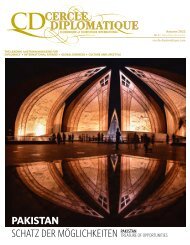CERCLE DIPLOMATIQUE - issue 04/2019
CD is an independent and impartial magazine and is the medium of communication between foreign representatives of international and UN-organisations based in Vienna and the Austrian political classes, business, culture and tourism. CD features up-to-date information about and for the diplomatic corps, international organisations, society, politics, business, tourism, fashion and culture. Furthermore CD introduces the new ambassadors in Austria and informs about designations, awards and top-events. Interviews with leading personalities, country reports from all over the world and the presentation of Austria as a host country complement the wide range oft he magazine.
CD is an independent and impartial magazine and is the medium of communication between foreign representatives of international and UN-organisations based in Vienna and the Austrian political classes, business, culture and tourism. CD features up-to-date information about and for the diplomatic corps, international organisations, society, politics, business, tourism, fashion and culture. Furthermore CD introduces the new ambassadors in Austria and informs about designations, awards and top-events. Interviews with leading personalities, country reports from all over the world and the presentation of Austria as a host country complement the wide range oft he magazine.
- No tags were found...
Create successful ePaper yourself
Turn your PDF publications into a flip-book with our unique Google optimized e-Paper software.
L’AUTRICHE FUTURE LAB
Stefan Vilsmeier
„Die Zukunft der Medizin ist datengetrieben.“
“The future of medicine is data-driven.”
BRAINLAB
ABOUT THE AUTHOR
Stefan Vilsmeier
Als Autodidakt in Software-Programmierung,
verfasste er bereits mit 16 Jahren ein Buch über
3D-Grafik und legte damit den Grundstein seines
Unternehmens: Mit den Einnahmen der mehr als
50.000 verkauften Exemplare gründete er 1989
Brainlab, mit dem Ziel, präzisere und schonendere
chirurgische und radiologische Behandlungen zu
ermöglichen.
Für seine wirtschaftlichen und technologischen
Erfolge zeichnete ihn die Beratungsgesellschaft Ernst
& Young als „World Entrepreneur des Jahres 2002“
aus und der deutsche Ministerpräsident Edmund
Stoiber verlieh ihm als höchste Ehrung des Freistaates
den Bayerischen Verdienstorden.
Seit 2018 berät Stefan Vilsmeier im Rahmen des
Innovationsdialogs die Bundesregierung zu
Zukunftsthemen wie Digitalisierung, Künstliche
Intelligenz und Quantenmechanik.
As a self-taught software programmer, he already
authored a book on 3D graphics at the age of 16,
thereby creating the foundation for this business:
With the proceeds from more than 50,000 sold
copies, he founded Brainlab in 1989 with the goal of
making more precise and less invasive surgical and
radiological treatments possible.
For his economic and technological success, the
consulting firm Ernst & Young called him the “World
Entrepreneur of 2002” and German Minister-President
of Bavaria Edmund Stoiber awarded him the
state’s highest honour, the Bavarian Order of Merit.
Since 2018, Stefan Vilsmeier has been advising the
German federal government as part of an innovation
dialogue on future topics such as digitalisation,
artificial intelligence and quantum mechanics.
Die digitale Erfassung von prä-, intra- und post-operativen Daten
ermöglicht neuartige Behandlungen. The digital collection of pre-,
intra- and postsurgical data allows for completely new treatments.
Der OP ist in Krankenhäusern sowohl
der Hauptwerttreiber, als
auch das größte Effizienzleck. Das
liegt daran, dass Operationssäle und die vorund
nachbereitenden Prozesse weitgehend
analog ablaufen und sich der systematischen
Auswertung entziehen. Die digitale Erfassung
von prä-, intra- und post-operativen
Daten in Kombination mit dem Einsatz von
KI und Big Data ermöglicht neuartige chirurgische
und onkologische Behandlungen,
verbesserte Behandlungsqualität und mehr
Effizienz im OP.
Brainlab weist durch bildgebende Verfahren
jedem einzelnen Bildpunkt eine einheitliche
anatomische Adresse in einem generischen
Modell zu, ähnlich wie
Koordinaten in einem Atlas. Das ermöglicht
uns Rückschlüsse: Die Relation zwischen
Strukturen, Veränderungen und Abweichungen
können berechnet, über Patienten
hinweg verglichen und neue Erkenntnisse
über Behandlungen gewonnen werden.
Brainlab erschließt so die Anatomie für die
Verarbeitung mit Big Data und KI.
Ein weiterer Schritt ist analoge Abläufe
im OP digital zu erfassen: Das kann das Verfolgen
des Fokuspunkts eines Mikroskops
auf dem Weg zum Tumor sein, die Analyse
der Reihenfolge der verwendeten Instrumente
oder die ausgewählten Zugangsrichtungen
des Chirurgen. Doch erst die Verknüpfung
dieser Informationen über viele
Patienten hinweg lässt Schlussfolgerungen
zu: So wie für die GPS-Navigation das Bild
einer Straßenkreuzung erst in Kombination
zur Lage Erkenntnisse liefert, ist die Aufnahme
eines Blutgefäßes erst in Relation zur
restlichen Anatomie aussagekräftig. Und
durch die Kombination mit Sensoren, die
heute schon bei Tausenden von Eingriffen
eingesetzt werden, lassen sich Daten erzeugen,
die neue Erkenntnisse ermöglichen.
Als wichtige post-operative Erkenntnisquelle
gilt heute, Informationen aus Arztbriefen
digital zu verarbeiten. Ihre Erstellung
erfolgt als Freitext und ihre
Auswertung durch Software ist nicht möglich.
Sinnvoller ist die Erfassung der Informationen
durch Ärzte in standardisierten
Datenfeldern durch Endgeräte wie Tablets.
Das gilt auch für sog. Patient Reported
Outcomes, die heute noch als Freitext entstehen.
Ein regelmäßiges Feedback der Patienten,
per E-Mail oder Smartphone liefert
wiederum Daten, die für digitale
Verarbeitung geeignet sind.
Unsere Technologie wollen wir als Betriebssystem
der Chirurgie einer breiten
Patientenbasis zugänglich machen: Wir
werden sie Partnern und Mitbewerbern lizensieren
und daraus entwickelte Anwendungen
auf einer offenen Digitalplattform
für die Chirurgie anbieten. Eine solche Digitalplattform
ermöglicht die Skalierung
der angebotenen Anwendungen in der
Breite und die Amortisierung von komplexen
KI-Algorithmen.
Der Rohstoff der digitalen Medizin sind
anonymisierte Patientendaten. Doch wem
gehören die Daten? Den Patienten. Ihnen
muss der Zugriff auf ihre Behandlungsdaten
gesetzlich garantiert werden. Der Patient
muss vollständig kontrollieren, wer
Zugriff auf seine Daten hat. So wird verhindert,
dass Pharma- und Medizintechnikhersteller
diese Daten erfassen und in abgeschlossenen
Systemen unzugänglich
machen und sie Patienten eine freie Wahl
ihrer Behandlungen verwehren.
Es besteht bereits ein Wettlauf der
Tech-Konzerne um die Daten, an dessen
Ende einige wenige Akteure die medizinische
Versorgung nach rein wirtschaftlichen
Gesichtspunkten gestalten werden.
Um ein solches Szenario zu verhindern
gilt es, ein liberal zugängliches Ecosystem
anonymisierter Patientendaten zu schaffen.
Dies erfordert Aufklärung der politischen
Akteure und der Patienten voraus.
PHOTOS: BRAINLAB
In hospitals, it is the operating room that
is both the main value driver as well as
the biggest source of inefficiency. This is
due to the fact that operating rooms and the
preparatory and follow-up processes are
still carried out on a primarily analogue basis
and are therefore excluded from systematic
analysis. The digital collection of pre-,
intra- and postoperation data can – in combination
with the use of AI and big data –
allow for completely new surgical and oncological
treatment types, improved
treatment quality and increased efficiency
in the operating room.
Through the use of imaging techniques,
Brainlab can attribute to each pixel a uniform
anatomical address within a generic
model, similar to the coordinates of an atlas.
This allows for unique insights: The relations
between structures, changes and
deviations can be calculated, compared across
patients and new insights about treatments
can be gained. In that sense, Brainlab
opens up human anatomy for
processing through big data and AI.
An additional step is the digital capture
of analogue processes in the operating
room. This could be the tracing of the focus
point of a microscope on the way to a tumour,
the analysis of the series of instruments
used or a surgeon’s chosen movements
and directions. But it is only the
linking of this information across several
patients that enables the discovery of new
findings: Just like an image of a street crossing
in GPS navigation only provides new
information in combination with a particular
location, the recording of a blood vessel
is only significant in relation to the remaining
anatomy. And with the
combination of sensors that are already in
use during thousands of procedures today,
new data can be collected that could lead to
entirely new insights.
One important post-surgical source of
medical insight today is the digital processing
of information from doctor’s letters.
These are generally written by hand and
cannot be analysed through software. It
would make more sense to capture this information
by providing doctors with standardised
data fields with the use of enduser
devices such as tablets. This also
applies to the so-called patient-reported
outcomes, which today are still written
freely by hand. Regular feedback from patients
via email or smartphone, on the other
hand, could provide additional data suitable
for digital processing.
We want to make our technology available
to a wide range of patients in the form
of an operating system for the operating
room. We will license it to partners and
competitors and offer the thereby developed
applications on an open and digital
surgery platform. Such a platform will allow
for the broad scaling of the applications
on offer and the amortisation of complex
AI algorithms.
The most basic resource of digital medicine
is anonymised patient data. But who
does the data belong to?
The patients. They have
lawfully guaranteed access
to their treatment
data. The patient must be
able to check at all times
who exactly has access to
their data. This will prevent
pharmaceutical corporations
and medical
technology manufacturers
from collecting this
data and making it inaccessible
within a closed
system and denying patients
free choice when it
comes to their treatment.
A race is already underway among tech
corporations for this data and a handful of
actors in medical care will shape this industry
based purely on economic interest.
In order to prevent such a scenario, a liberally
accessible ecosystem based on anonymised
patient data must be created. This
will require the education of political figures
as well as patients.
Das Münchener Unternehmen Brainlab
entwickelt, produziert und vertreibt softwaregestützte
Medizintechnologie und ermöglicht
somit Zugang zu optimierten, effizienteren
sowie minimal-invasiven Patientenbehandlungen.
Mit der Technologie von Brainlab können
Entwicklungen im Bereich Neurochirurgie,
Radiochirurgie sowie in anderen chirurgischen
Fachdisziplinen vorangetrieben werden.
Brainlab beschäftigt weltweit 1.400 Mitarbeiter
und hat über 12.850 Systeme in weltweit über
100 Ländern installiert.
The Munich-based company Brainlab develops,
produces and distributes software-based
medical technologies, thereby allowing access
to optimised, more efficient and minimally
invasive patient treatments. With the help of
Brainlab technologies, developments in the area
of neurosurgery, radiosurgery and other surgical
disciplines have been advanced further.
Brainlab employs 1,400 people around the
world and has installed more than 12,850 of its
systems in more than 100 countries.
brainlab.com
Die Zukunft der Medizin: ein
digitaler OP. The future of
medicine: a digital operating
room.
Die Zentrale von
Brainlab in München,
Deutschland.
Brainlab‘s headquarter
in Munich, Germany.
80 Cercle Diplomatique 4/2019
Cercle Diplomatique 4/2019
81

















